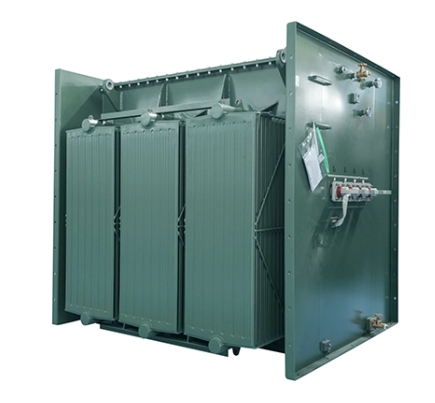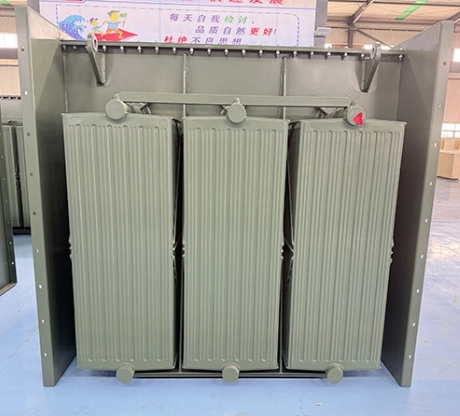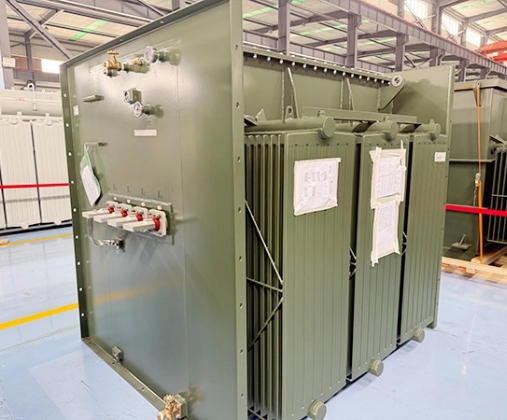

PAD MOUNTED TRANSFORMER-ZGS-Z-3150-25-0.415
- Home
- Product
PAD MOUNTED TRANSFORMER-ZGS-Z-3150-25-0.415
The ZGSL-Z-3150-25-0.415 is a high-performance pad-mounted transformer designed with 25kV primary voltage and 415V secondary voltage, featuring a rated capacity of 3150kVA. This transformer offers outstanding characteristics:
- ✔ Fully sealed corrosion-resistant steel enclosure with IP55 protection rating, suitable for various harsh outdoor environments;
- ✔ Equipped with high-efficiency cooling system, ensuring temperature rise below 65K at full load operation;
- ✔ Low-loss design with no-load loss ≤3.2kW and load loss ≤23.5kW;
- ✔ Passed rigorous type tests including lightning impulse and short-circuit withstand tests;
- ✔ Optional intelligent monitoring system for real-time operation status tracking.
This product is widely used in medium-voltage distribution systems for industrial parks and commercial centers, providing safe and reliable power conversion solutions. We offer customized services to meet specific technical requirements including special voltage ratios and protection levels.
-
Unmatched Energy Efficiency (99.16% Verified)
As a premier transformer manufacturer, we proudly introduce our flagship ZGSL-Z-3150-25-0.415 pad mounted transformer – engineered for heavy-duty power distribution with exceptional reliability and efficiency. Our electrical transformer achieves industry-leading 99.16% efficiency at full load (3150kVA), with ultra-low losses (3.2kW no-load/23.5kW load). Independent tests confirm 30% better performance than standard units, delivering substantial energy savings for industrial users. -
Reliability and Durability
Constructed to withstand harsh environmental conditions, pad mounted transformers boast a robust design, contributing to their long service life. They resist weather elements, vandalism, and wildlife interference, ensuring consistent and reliable power distribution over time. -
Ease of Installation and Maintenance
The ground-level placement of pad mounted transformers simplifies the installation process, requiring only a concrete pad and electrical connections. This accessibility also makes routine maintenance and inspections more straightforward, reducing operational costs and less downtime. -
Enhanced Security
The lockable enclosures of pad mounted transformers provide an additional layer of security, protecting against unauthorized access and tampering. This is particularly important in areas susceptible to vandalism or where public safety is a concern.
| Type | Pad mounted transformer |
|---|---|
| Model | ZGSL-Z-3150/25-0.415 |
| Installation | Outdoor |
| Altitude | ≤1000m |
| Rated Power | 3150KVA |
| Cooling Method | ONAN |
| Primary Voltage | 25kV |
| Secondary Voltage | 415Y/240V |
| Rated Frequency | 60HZ |
| Insulation oil | Mineral oil |
| Tapping Range | +2×2.5% |
| Temperature rise (℃) | 65 |
| Connection Group | Dyn1 |
| Impedance (%) | 6 |
| Standard | IEEE C57.12.00 IEEE C57.12.90 |
| Dimensions (mm) | 1200×1000×2000 |
| Total weight (kg) | 7500 |
Pad-mounted transformers are ground-level, enclosed electrical transformers commonly used in urban and suburban power distribution systems. Their key applications include:
-
Underground Power Distribution Networks
Widely deployed in areas with underground cables (e.g., residential neighborhoods, commercial districts) to step down medium voltage (e.g., 15–35 kV) to low voltage (120/240V or 480V) for end users. -
Commercial & Industrial Facilities
Provide localized power transformation for shopping malls, office buildings, factories, and data centers where aesthetics, safety, and space efficiency are priorities. -
Residential Subdivisions
Serve as distribution nodes in housing developments, ensuring safe and reliable power delivery while minimizing visual and noise impact. -
Renewable Energy Integration
Used in solar/wind farms to step up or down voltage before feeding into the grid or supplying nearby communities. -
Public Infrastructure
Support hospitals, schools, airports, and street lighting systems by integrating seamlessly into urban landscapes. -
Temporary Power Supply
Deployed for construction sites or emergency power restoration due to their modularity and quick installation.
1. Shipment, Handling, Rigging & Storage
- Inspect the transformer for shipping damage upon arrival. Report any issues to the carrier immediately.
- Use only designated lifting lugs and appropriate rigging equipment rated for the transformer’s weight. Never lift by bushings or radiators.
- Store the transformer upright on a level, dry surface. Protect from weather and flooding. For long-term storage, seal all openings and monitor silica gel breathers.
2. Transformer Installation
- Crane Lifting & Rigging: Attach slings to marked lifting points. Use spreader bars if needed to avoid tank deformation.
- Jack & Skid: For short moves, use jacks and skids under the base. Move slowly and avoid sudden movements.
- Foundation: Place transformer on a flat, solid, non-combustible pad with proper drainage. Anchor as required by local codes.
- Compartment: Ensure HV and LV compartments are accessible and free of debris. Check gasket seals for integrity.
- Grounding: Connect tank and neutral points to a reliable earth ground per IEEE/NEC standards.
- High Voltage & Low Voltage Connections: Clean and torque all cable terminations to manufacturer’s specifications. Use proper lugs and insulation.
- Dielectric Fluid: Check oil level and top up with approved fluid if necessary. Sample oil for moisture and dielectric strength if required.
- Transformer Pressure: Verify pressure relief device is operational. Check for correct internal pressure or vacuum as specified.
- Other Aspects: Install required signage and barriers. Confirm all accessories are installed and functional.
3. Pre-Energization
- Perform insulation resistance and turns ratio tests. Confirm all connections are tight and correct.
- Verify tap changer is set to the correct position.
- Check oil level, absence of leaks, and operation of gauges and alarms.
4. Post-Energization
- Monitor for abnormal noise, vibration, or temperature rise.
- Check for oil leaks and monitor gauges for pressure and temperature.
- Record initial load and voltage readings.
5. Switching Operation
- Operate switches only under no-load conditions unless rated for load-break.
- Follow lockout/tagout procedures before maintenance.
- Use insulated tools and wear appropriate PPE.
6. Protection
- Ensure fuses, surge arresters, and relays are installed and rated correctly.
- Test protection devices per manufacturer’s recommendations.
7. Accessories
- Check operation of temperature gauges, pressure relief devices, oil level indicators, and gas relays.
- Maintain and calibrate accessories as required.
8. Maintenance
- Perform periodic inspections for leaks, corrosion, and proper operation of all devices.
- Sample and test dielectric fluid annually or as recommended.
- Clean bushings and compartments regularly.
9. Field Acceptance Test Guidelines
- Conduct insulation resistance, turns ratio, and winding resistance tests before energization.
- Compare results with factory test reports and standards (e.g., IEEE C57.12).
- Document all test results for future reference.
10. Tables and Procedures
- Refer to the manufacturer’s manual for torque values, oil specifications, and test limits.
- Maintain a log of all inspections, tests, and maintenance activities.
- Follow standard operating procedures for all field operations.
RELATED PRODUCTS






